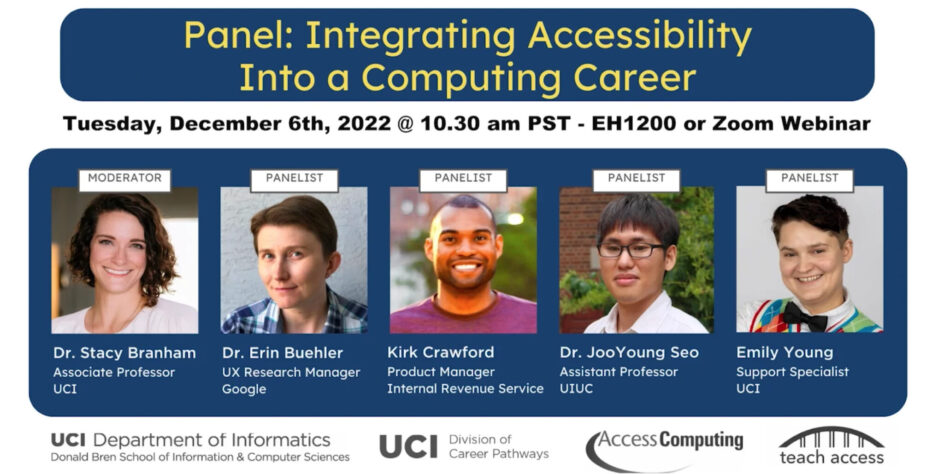Informatics Course Includes Webinar on Integrating Accessibility Into a Computing Career
The webinar started with a list of pet peeves: classifying accessibility as “nice to have” instead of as a prerequisite, forgetting alt text on images, omitting labels on buttons, and seeing an IT professional who isn’t committed to accessibility. Participants attending the Integrating Accessibility Into a Computing Career webinar quickly learned how those four items irk the following four panelists, respectively:
- Erin Buehler, UX research manager at Google;
- Kirk Crawford, product manager at the Internal Revenue Service (IRS);
- JooYoung Seo, assistant professor of information sciences at the University of Illinois Urbana-Champaign; and
- Emily Young, support specialist at UC Irvine.
Informatics Professor Stacy Branham of UCI’s Donald Bren School of Information and Computer Sciences (ICS) moderated the Dec. 6, 2022 panel as part of her “IN4MATX 131: Introduction to Human Computer Interaction” course. (You can watch the panel, which was not limited to just students, online.)
“Accessibility is increasingly important in tech careers,” says Branham, “but few tech classes teach accessibility topics and prepare students for these careers.”
 Accessibility in Computing
Accessibility in Computing
“We are joined here today by an exciting lineup of professionals who are applying accessibility practices in their computing careers,” said Branham at the start of the webinar. Students then learned about digital accessibility work across a variety of sectors.
At Google, Buehler co-leads a team called Abilities, Innovation, and Research, which is a combination of researchers and designers who help create assistive technologies and features, such as the Lookout app for Android. Lookout uses computer vision to help people with low vision or blindness gather information and complete tasks. Other tools help people with cognitive disabilities and differences or motor and dexterity differences.
At the IRS, Crawford leads a cross-functional team of UX designers, researchers, business product owners, product stakeholders and IP partners, working across the agency to develop critical digital products. He also engages with accessibility teams to ensure compliance with Section 508 of the Rehabilitation Act, which requires access to electronic and information technology provided by the federal government.
Seo, who focuses on accessible computing and inclusive STEM education for people with disabilities, has a visual impairment and uses assistive technologies such as a screen reader. “I’m working on making learning technologies more accessible for people with disabilities … [including] accessible data science tools [and] data visualization tools, and tangible robotic kits for blind and low vision learners.”
Young is the quality assurance lead responsible for functional testing of UCI’s web apps. They also do some frontend work, including design, which is where accessibility comes into play. “I’ll also do some accessibility testing, and I try to incorporate accessibility things from the beginning if we’re designing new applications.”

The panelists discussed how they first came to work in and advocate for digital accessibility and outlined specific projects and successes. They also answered questions, discussing, for example, accessibility certifications and training, such as CPACC (Certified Professional and Accessibility Core Competencies) of the IAAP (International Association of Accessibility Professionals), the Level Access blog, Deque webinars, and ADA.gov [Americans with Disabilities Act] resources.
The discussion ended on a hopeful note, with the group talking about how the tech industry has advanced its accessibility practices, and how it could continue to improve going forward.
“Thank you for your time. Thank you for your advocacy,” Branham said in conclusion. “You inspire me, and I think you just inspired hundreds of students and allies.”
Teach Access
The panel discussion was funded through a grant from Teach Access, which aims to enhance students’ understanding of digital accessibility as they learn to design, develop and build new technologies. Teach Access sponsored the webinar, along with ICS, UCI’s Division of Career Pathways, and Access Computing.
“It was interesting for me to see even government institutions like the IRS have hired talented researchers and tech developers to address accessibility in innovative ways,” says recent ICS graduate Navid Salehnamadi, a who earned his Ph.D. in software engineering. “It was insightful to see that the real challenge lies within the companies and their management in allocating budget and time to make digital products more accessible.” Overall, he was very impressed with the panelists.
“The panel was a valuable source of information and inspiration for students who are looking to make a career in computing and bring about a positive impact in the field of accessibility,” says Salehnamadi.
— Shani Murray